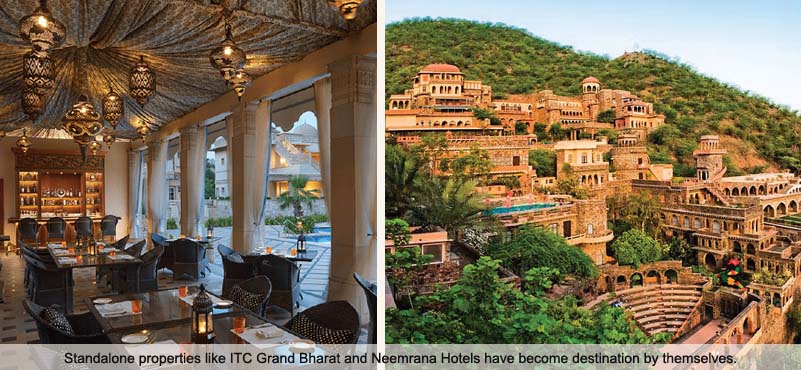There is a vacuum – nobody to look into espousing ‘tourism’ in all its colours. Hotels can fill this vacuum, as the most logical stakeholders, the most visible torch bearers of travel and tourism. When they can come together, to speak for a city’s tourism push, they will succeed in their efforts as a collective.

Editor, Destination India Tourism Exchange
The last few years have witnessed an unprecedented euphoria around domestic tourism. Unheard of hotel rates, mind boggling occupancies in lesser known and frequented destinations, have come to pass. What we have seen is domestic travel driven by a hospitality industry in an overdrive. India’s hotels have been quick on the draw, taken initiatives at every small sign – in this case, every long week end, every other festival, curated events, special packages, whatever it takes. Most of this has been promoted by social media activity or by word of mouth. Indeed, if there was any doubt in earlier times, India’s hotels have been in the forefront of this new uprising.
No doubt, either, that this has been made possible most by the growing and affordable infrastructure, especially road and air travel. What has been called, aas paas tourism, has been made convenient by fast paced connectivity, largely family travel in India’s fast growing SUV market. A trip to the hills, for a family of four or six, gets bundled within ten thousand rupees of petrol cost; perhaps less than 10% of what it would cost by air to Goa, or elsewhere.
The bottom line is, however, that it is hotels that are doing the calling and more than willing customers, lapping up their new found ability to spend, like never seen before. Less haggling, more willing to make the statement, that they too are travelling. And spending. They, too, have arrived; when buying expensive bags is less touted than having stayed at the most expensive resort.
In many cases it is the lone resort that does the beckoning, a stand-alone resort tucked away as the big getaway. Like, for instance, any of the Neemrana hotels. Or, a hotel like ITC Grand Bharat at Manesar, or the Karma Lakelands.

In other places, established destinations like Goa, or Jaipur, or Agra, there is the collective of hotels, where each may vie with the other in a competitive environment. It is here that there is a need for coming together of similar positioned properties to engage in collective marketing of the destination. For the greater good of all, for each one of them. A collective of Aerocity city hotels, already eleven of them, and growing, could be another coming together!
Usually, a catalyst is missing, to bring them together; an agency or a body or a person who enjoys confidence of all. One who can bell the cat into making a beckoning and enticing ‘meow’.
We witnessed this most successfully, many decades ago, while Goa Tourism was introducing the concept of monsoon holidays, hoping to entice Indians in their off-season, when they saw almost negligible footfalls. Here, the catalyst was the state department of tourism, or the Goa Tourism Development Corporation, under its then dynamic MD, Vinod Kumar Duggal, who later became DG-Tourism at the centre, then Home Secretary and retired as Governor of Manipur. What had come first, then, the desire of the state government to attract more tourists, or the hotels that went through very lean months through the summer and the rains? No matter, it was a marriage of necessity, both eager to engage more tourism. Since then, many decades later, much maturity has come into the industry, as best market practices. But what has possibly emerged is that both the entities, the state and the industry, are, by and large, doing their own.
What could happen, at this stage of development, not in Goa alone, but in most urban cities, destinations like Ahmedabad, Bengaluru, and numerous others where there are larger collectives of hotels, each successful, can come together, for the greater good of the destination.
Let us not overlook, most cities do not have any tourism promotion body. It is essentially individual hotels doing their own individual bit. But if they came together, as a body, sat down with the city administration, or the local government, to effectively start marketing Indian cities/destinations. In this scenario, we are looking at hotels becoming the driving force, not just to market their own hotels, but the city, as a whole. From the present, where hospitality has already emerged as the single biggest driving force, we are seeing this collective approach as the most logical next step.
India’s ‘tourism’ industry remains fragmented, encompassing such a large and various canvas, where diverse events, traditional festivals, marriage seasons, whatever, each operate in silos. Whether it is at the centre or in the states, the writ of the tourism ministry/department remains hugely restricted, there is an acute vacuum – nobody to look into espousing ‘tourism’ in all its colours. Hotels can fill this vacuum, as the most logical stakeholders, the most visible torch bearers of travel and tourism. When they can come together, to speak for the city’s tourism push, they will succeed in their efforts as a collective. An airline partner can add to the halo. The time is now, when business is good, when it is also time to look ahead.








